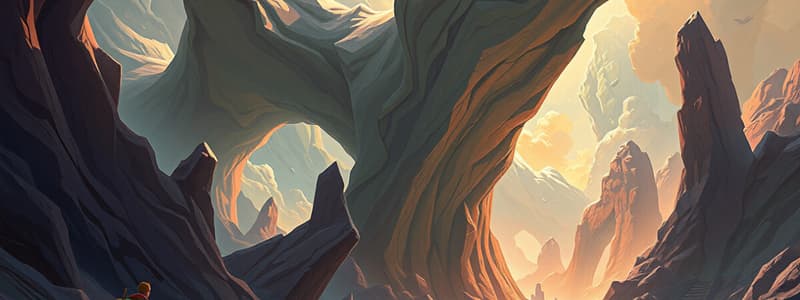Podcast
Questions and Answers
What does three-dimensional mean?
What does three-dimensional mean?
Having height, width, and depth.
Which of the following are considered elements of art? (Select all that apply)
Which of the following are considered elements of art? (Select all that apply)
- Color (correct)
- Sequence
- Form (correct)
- Line (correct)
What does two-dimensional mean?
What does two-dimensional mean?
Having height and width.
What is a shape in art?
What is a shape in art?
What is 3-D modeling?
What is 3-D modeling?
What is the definition of form in art?
What is the definition of form in art?
What does scale refer to in art?
What does scale refer to in art?
What is volume in terms of three-dimensional figures?
What is volume in terms of three-dimensional figures?
What is mass in art?
What is mass in art?
What does space refer to in visual art?
What does space refer to in visual art?
What is texture in art?
What is texture in art?
What is a geometric form?
What is a geometric form?
What is a plane in artistic terms?
What is a plane in artistic terms?
What is an organic form?
What is an organic form?
What does abstract mean in art?
What does abstract mean in art?
What is color in art?
What is color in art?
What is relief in artistic terms?
What is relief in artistic terms?
What does 'in the round' mean?
What does 'in the round' mean?
What is a facade?
What is a facade?
What is the foreground in art?
What is the foreground in art?
What is high relief?
What is high relief?
What is bas-relief?
What is bas-relief?
What is a stela?
What is a stela?
What is composition in art?
What is composition in art?
What does freestanding mean in art?
What does freestanding mean in art?
What is a focal point?
What is a focal point?
What is an axis in art?
What is an axis in art?
What is negative space?
What is negative space?
What does contrast mean in art?
What does contrast mean in art?
What is surrealism?
What is surrealism?
Flashcards are hidden until you start studying
Study Notes
Three-Dimensional and Two-Dimensional Art
- Three-dimensional art has height, width, and depth, creating a sense of volume and space.
- Two-dimensional art includes only height and width, lacking depth.
Elements of Art
- Fundamental vocabulary of art includes line, shape, form, volume, mass, texture, value, space, color, motion, and time.
Modeling Techniques
- 3-D modeling uses computer-generated imagery to create the illusion of three-dimensional objects that can display movement.
Important Definitions
- Form: Objects defined in three dimensions.
- Volume: The space an object occupies or encloses.
- Mass: Illusion of weight, density, and bulk in volume.
- Scale: Size of an object or artwork relative to others.
Shapes and Surfaces
- Shape: Two-dimensional areas defined by lines or color changes.
- Plane: Flat two-dimensional surfaces for drawing or painting; can also be implied through light interactions.
- Texture: Surface quality of artwork, described as fine/coarse or detailed/lacking detail.
Types of Forms
- Geometric Form: Predictable, mathematically derived shapes with defined planes and curves.
- Organic Form: Unpredictable, irregular shapes resembling the natural world.
Art Presentation
- Relief: Raised form against a flat background; example includes coin designs.
- In the Round: Freestanding sculptures that can be viewed from any angle.
- Fascia: Any side of a building, typically the front or entrance.
Composition and Design
- Foreground: The part of a work closest to the viewer.
- High Relief: Deep projections from the background in carved panels.
- Bas Relief: Slightly raised carvings that barely project from the surface.
Artistic Concepts
- Stela (stelae): Upright stone slabs decorated with inscriptions or relief carvings.
- Composition: Overall design and organization of an artwork.
- Freestanding: Sculptures independent of walls that allow a 360-degree view.
Focal Point and Negative Space
- Focal Point: Center of interest that draws viewer attention to key elements.
- Negative Space: Empty spaces created by positive shapes in the artwork.
Contrast and Artistic Movements
- Contrast: Drastic differences in elements such as color or value highlighted together.
- Surrealism: An artistic movement from the 1920s, influenced by dreams and the subconscious.
Studying That Suits You
Use AI to generate personalized quizzes and flashcards to suit your learning preferences.




